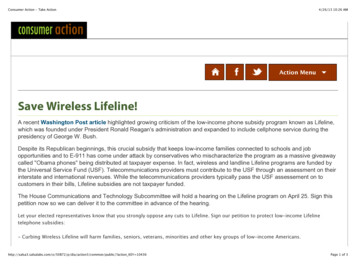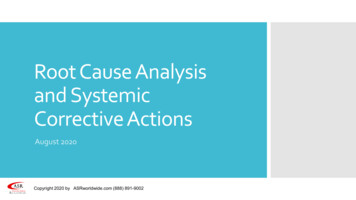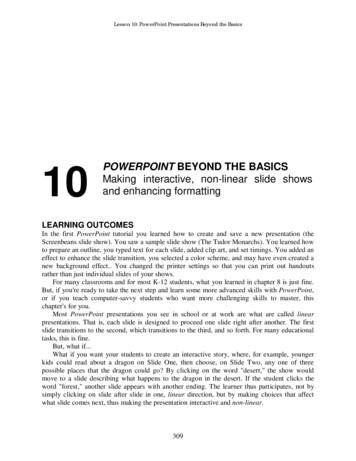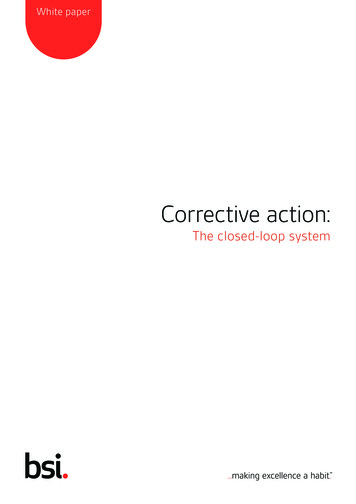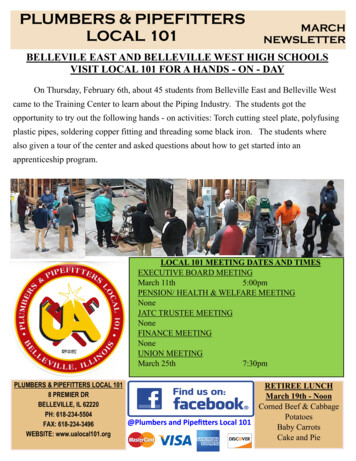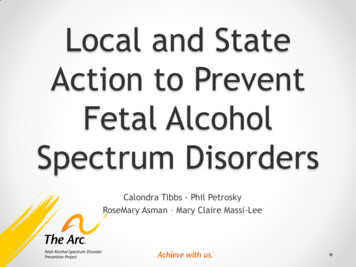
Transcription
Local and StateAction to PreventFetal AlcoholSpectrum DisordersCalondra Tibbs - Phil PetroskyRoseMary Asman – Mary Claire Massi-Lee
Objectives Increase awareness of FASD prevention activities atlocal and state levels, specifically Ohio's Not a SingleDrop initiative and Michigan's FASD Community Grants. Learn about strategies to support education andscreening of pregnant women for exposure to alcohol. Learn how to engage communities in FASD preventionactivities through partnerships at the local and statehealth departments.
PresentersCalondra D. Tibbs, MPHNational Association of County& City Health Officials
PresentersPhil PetroskyOhio Department of Health,WIC Program
PresentersRose Mary Asman, RN, MPAMichigan Department of CommunityHealth, Division for Family andCommunity HealthMary Claire Massi-LeePublic Health, Delta andMenominee Counties,Substance Abuse Services
Overview of Fetal AlcoholSpectrum Disorders
Fetal Alcohol SpectrumDisorders (FASD) Group of conditions that occur in a person whosemother drank alcohol during pregnancy Effects may include physical problems, behavioralproblems, and difficulty with learning FASD is not a clinical diagnosis Effects can range from mild to severe
Types of FASDsFetal Alcohol Syndrome (FAS)Alcohol-Related Neurodevelopmental Disorder(ARND)Alcohol-Related Birth Defect (ARBD)
Signs, Difficulties andDisabilities by Age LevelAge LevelSigns, Difficulties, and DisabilitiesINFANTSLow birth weight; irritability; sensitivity to light, noises and touch;poor sucking; slow development; poor sleep-wake cycles; andincreased ear infections.TODDLERSPoor memory capability; hyperactivity; lack of fear; no sense ofboundaries; and a need for excessive physical contact.GRADEShort attention span; poor coordination; and difficulty with both fineSCHOOL YEARS and gross motor skills.OLDERCHILDRENTrouble keeping up with school; and low self-esteem from recognizingthat they are different from their peers.TEENAGERSPoor impulse control; cannot distinguish between public and privatebehaviors and must be reminded of concepts on a daily basis.ADULTSNeed to deal with many daily obstacles, such as affordable andappropriate housing, transportation, employment and moneyhandling.
FASD Facts Scientists believe that there are at least 3 times thenumber of FASDs as FAS An estimated 0.2 – 1.5 cases of FAS occur for every 1,000live births Each year 40,000 babies are born with an FASD FASDs are a leading preventable cause of intellectualdisabilities
FASD in Comparison
Financial Impact of FASD FASDs cost about 6 billionper year The lifetime cost of caringfor one individual withFASD is estimated to begreater than 2 million For a child with identifiedFAS, incurred health costsare 9 times higher thanfor children with an FASD
Facts aboutAlcohol Use 7.6% of pregnant women and51.5% of non-pregnant womenreported drinking alcohol in thepast 30 days 1.4% of pregnant women and15.0% of non-pregnant womenreported binge drinking in thepast 30 days The highest estimates ofreported alcohol use amongpregnant women were: Aged 35-44 years White College graduates Employed
FASD Prevention &Reduction Prevention begins with communication Ask all women of child-bearing age about alcohol useTalk about the effects of alcohol on an individual and on a fetus Brief interventions Outreach, screening, referral, and other activities that promote the health ofthe mother and the fetus Public Health Messaging No known safe amount of alcohol use during pregnancy or while trying to getpregnant FASDs are completely preventable if a woman does not drink alcohol duringpregnancy
FASD Resources The Arc http://www.thearc.org/learn-about/fasd Centers for Disease Control and Prevention (CDC) http://www.cdc.gov/ncbddd/fasd/index.html Substance Abuse and Mental Health Services (SAMSHA) http://www.fasdcenter.samhsa.gov/
Ohio’s FASDInitiativePhil Petrosky, Parent NetworkOhio FASD Steering CommitteeOhio Department of HealthPhil.Petrosky@odh.ohio.govAugust 28, 2014
Ohio’s FASD Initiative2003 - FoundationMrs. Hope Taft, First Lady of Ohio(Emeritus), in partnership with membersof the Ohio Family and Children First(OFCF) Cabinet Council, formed the OhioFASD Steering Committee. Originalcommittee included: nine state agencies,institutes of higher education, providersand parents.
Ohio’s FASD InitiativeOhio FASD Steering Committee State Agency Membership Ohio Department of AgingOhio Department of Alcohol and Drug Addiction Services merged into OhioDepartment of Mental Health and Addiction Services (July 2013)Ohio Department of EducationOhio Department of HealthOhio Department of Job and Family ServicesOhio Department of Medicaid (Launched July 2013)Ohio Department of Mental Health merged into Ohio Department of MentalHealth and Addiction Services (July 2013)Ohio Department of Developmental DisabilitiesOhio Department of Rehabilitation and CorrectionsOhio Department of Youth Services
Ohio’s FASD InitiativeOhio FASD Steering Committee AdvocacyMembership 7 Parents/CaregiversOhio Center for Autism and Low IncidenceOhio Family and Children First CouncilDouble ARC – Toledo, OhioMontgomery County ADAMHS BoardAkron Children’s Hospital Regional Genetics CenterLorain County General Health DistrictFirst Step Home (Women’s Center)Cincinnati Children’s Medical Center
Ohio’s FASD Initiative On Sept. 9, 2004, the FASD Steering Committeeheld a Town Hall Meeting to increase awareness ofthe challenges faced by Ohio’s children andfamilies. This testimony and a needs assessment conductedin 2005 with The Ohio State University’s Center forLearning Excellence, using the Partnerships forSuccess Strategic Planning Process, led to a courseof action based on key findings.
Ohio’s FASD InitiativeStrategic Planning Findings Many professionals who provide services to children andfamilies in Ohio are ill-prepared to address FASD. Children are often diagnosed with several mental andphysical health disorders that can lead to a variety ofuncoordinated services. New and existing servicesshould be designed and coordinated to screen for FASD.
Ohio’s FASD InitiativeStrategic Planning Findings With the exception of a few areas of the state, servicesavailable to individuals affected by FASD areinadequate. There are few services available for parents, fosterparents and other caregivers, who play key roles inpromoting the welfare of children affected by FASD.
Ohio’s FASD InitiativeStrategic Planning Findings Efforts should be undertaken to establish formalrecognition of FASD. Policies should be developed andadopted that define how FASD is addressed ineducational settings. Ohio-specific FASD prevalence data should be collectedon a continuing basis.
Ohio’s FASD InitiativeSteering Committee MissionTo establish efficiency in state systemsresource allocation, coordination ofservices and augmentation of availableresources to address Fetal AlcoholSpectrum Disorders(FASD)
Ohio’s FASD InitiativeThe Strategic Plan Has Five Goals1. Increase the availability of services for those alreadyaffected by FASD and for parents and other caregivers;2. Increase awareness regarding the risks associated withalcohol use during pregnancy;3. Provide FASD-specific education and training foragencies, organizations and professionals who provideservices to children and families with or at risk of FASD;
Ohio’s FASD InitiativeThe Strategic Plan Has Five Goals4. Adopt appropriate FASD screening tools and protocolsand increase access to screening; and5. Create and implement a data tracking system to trackFASD risk factors, prevalence, and incidence in Ohio,and measure progress toward reaching the other fourgoals.
Ohio’s FASD InitiativeFASD Parent Network The Ohio FASD Parent Network is a workgroup of the SteeringCommittee. Their mission is to increase FASD awareness andprovide information and resources to families and caregivers aswell as organizations serving individuals affected by FASD. The parent network has held meetings in five Ohio regions forinput from families about their experiences with FASD. Feedback isprovided to the Steering Committee to help shape Ohio goals andpriorities Three parent network families participated in an FASD trainingvideo for educators entitled: In Their Own Words
Ohio’s FASD InitiativeOn August 16, 2005, the 1st Ohio FASD Conference washeld with expert featured speakers: Dr. Larry Burd, Dr.Susan Astley, Ira Chasnoff, and Kathleen Mitchell. About 350 families, health & human serviceprofessionals, & teachers participated
Ohio’s FASD InitiativeOhio's FASD Web Sitehttps://notasingledrop.mh.state.oh.us/Launched in April 2006, the site includes featured linksfor: definition of FASD, information on Ohio’s FASDinitiative, evidenced-based practices, screening anddiagnosis, living with FASD, and resources including Ohio’sMarketing Toolkit and FASD Generalist Training PowerPoint
Ohio’s FASD Initiative
Ohio’s FASD InitiativeApril 2006 – FASD AwarenessThe Ohio FASD universal marketing campaign kicked offwith public service announcements airing on WBNS 10TV,Ohio News Network, Mix 97.1FM and Ohio News NetworkRadio.Advertisements also ran in Columbus Parentmagazine and its sister publications throughoutthe state.
Ohio’s FASD InitiativeSeptember is FASD Awareness Month in OhioIn 2011, the Governor’s Resolution on FASD Preventionand Awareness Month was presented at an FASDcelebration of accomplishments in the Ohio StatehouseAtrium in Columbus.First Lady of Ohio, Karen Kasich, presented theGovernor’s Resolution to the Ohio FASD SteeringCommittee.
Ohio’s FASD InitiativeSeptember is FASD Awareness Month in OhioA letter for Maternal and Child Health Careprograms is provided with information to assistwith FASD awareness month efforts; the letterincludes attachments such as: Governor’s FASD Month DesignationFASD Awareness Day Suggestions SheetFASD Fill-in Press ReleaseFASD Fill-in Letter to Elected OfficialsOhio FASD Facts Sheet
Ohio’s FASD InitiativeOhio FASD Fast Facts Sheet
Ohio’s FASD InitiativeOhio FASD Awareness ActivitiesIn 2010, provided FASD Training for Parents and Providersin NW and SW Ohio Regions, & FASD Generalist Training inNE RegionIn 2013, provided FASDDiagnostic Capacity Trainingfor health care practitioners inSE & Central Ohio Regions
Ohio’s FASD InitiativeAdditional Ohio FASD Prevention EffortsASBI stands for Alcohol Screening Brief Intervention. It is a process modeled after California Women, Infants, andChildren’s program (WIC), which screens all pregnant WICparticipants for alcohol use, provides brief interventions toall who screen positive, follows those receiving briefinterventions during pregnancy, and refers them totreatment services. The goal is to educate pregnant women about the dangers ofdrinking alcohol while pregnant and, in turn, positivelyinfluence their decision about reducing or completelyceasing drinking.
Ohio’s FASD InitiativeAdditional Ohio FASD Prevention EffortsResults from Montgomery County, Ohio WIC pilot ASBIproject indicated that:o five percent of the pregnant women screened positive,o 97 percent abstained from further alcohol use after an initialbrief intervention, ando 99 percent abstained after two brief interventions.
Ohio’s FASD InitiativeAdditional Ohio FASD Prevention EffortsOhio WIC and the Montgomery County WIC program developed fourAlcohol Screening and Brief Intervention training modules for OhioWIC projects and other programs’ use.Modules are on the OhioTrain website: Course number 1044743ASBI process materials are available on the Ohio WIC website wic1.aspxClick on ASBI and scroll down to links for:o ASBI Screening and Scoring Toolso WIC Project CARE Health and Behavior Workbooko ASBI Follow-up Visit Questionso What is a Standard Drink
Ohio’s FASD InitiativeAdditional Ohio FASD Prevention EffortsAs of April 7, 2014 650 Ohio WIC employees had been trained on the ASBIprocess. There were 5,160 Ohio WIC participants that had beenscreened, and 564 brief interventions were given.
Ohio’s FASD InitiativeAdditional Ohio FASD Prevention EffortsNCADD Alcohol and Drug-Related Birth Defects AwarenessWeek May 2013 & 2014
Ohio’s FASD InitiativeAdditional Ohio FASD Prevention EffortsPrenatal Alcohol Use Fact Sheet – MCH Grant
Ohio’s FASD InitiativeThere is no safe amountand no safe time to drinkalcohol during pregnancy.
Questions?
Michigan FetalAlcohol DisordersProgramRose Mary Asman, RN, MPAMichigan Department of Community Health
Michigan Governor’s Dashboard of Prioritieswhat is the relevance to FASD?Researchers identified: Prenatal alcohol exposure and fetal death association more than 20 years ago. Fetal mortality was found to be 77 percent higher when alcohol was consumedduring pregnancy. Prenatal alcohol exposure is associated with a higher rate of infant death. Likelihood of miscarriage increased directly with alcohol consumption. Risk was twice as high in women consuming 1 ounce of absolute alcohol asinfrequently as twice a week.Curriculum for Addiction Professionals (CAP); Level urses/CapCurriculum/Accessed 10/28/2011
FASD Interagency Strategic Plan2012-2014o Goal 1: Prevention of Prenatal Alcohol Exposure Among Womenof Reproductive Age.o Goal 2: Intervention for Affected Children Birth to 18 Yearso Goal 3: Resource Development for FASDCurrently working on Michigan’s Strategic Plan for 2015-2020.Result of the Report to Senate & House Subcommittee onCommunity Health for FASD April 1, 2014.
Target Populationsfor FASD promotion, prevention, and intervention General PopulationsWomen of Reproductive AgeChildren & AdolescentsYouth in TransitionAdults Affected by FASD DD DiagnosisParents/Caretakers/Partners/Extended FamilyNative American Tribal Communities, Latino & AfricanAmerican Community-Based Projects Workforce Training
Components of theCurrent Michigan FASD ProgramNetwork OF 5 Diagnostic Clinics Diagnose Children, Birth to 18 years Provide Initial Plan of Care for the Child & Family8 Community-Based Projects Provide Local Community Prevention Initiatives Linkage & Referral to Local Community Services Family SupportTraining and Education 16 CDC FASD Certified Trainers in Michigan FASD State Coordinator
Statewide Alcohol Specific Screening forMedicaid Pregnant Women The Maternal Infant Health program (MIHP) is Michigan’s Medicaid Feefor Service home visiting program. Largest home visitation program in the state and all counties haveservices. Provided by: Federally qualified health centers; Home HealthAgencies; Hospital based clinics; Native American tribes; Privateproviders; Local and regional public health departments. Includes home visitation support and care coordination for pregnantwomen and infants. Uses evidence based, comprehensive Maternal and Infant RiskIdentifiers that determines the maternal or infant risks based on analgorithm designed into the database plus professional observation. Consists of standardized training, forms, interventions and plan ofcares.
MIHP Alcohol Specific Screening T-ACE embedded into the MIHP Risk Assessment that allpregnant women and mothers received at time ofenrollment into program Approximately 27,000 women and another 25,000 mothersof infants screened yearly 130,821 pregnant women Risk Assessments since 2008 28,967 (22.1 percent) admitted to having consumed alcoholwhile pregnant, Most reported quitting after finding outthey were pregnant www.michigan.gov/mihp
Public Health,Delta & Menominee CountiesFASDReduction Projecthttp://www.phdm.org/Public Health,Delta & Menominee Counties
Public Health, Delta &Menominee Counties Mission: To enhance the quality of life for thecommunity by preventing disease, encouraginghealthy lifestyles, and protecting the environment. Vision: To be a community leader in promoting,protecting, and providing for the public’s health.Public Health,Delta & Menominee Counties
Integration of FASD CommunityProject at PHDMBenefits for women of reproductive age Multiple programs offered that connect to Medicaidbeneficiaries and pregnant women Staff work in several programs: MIHPWICFamily PlanningEarly OnSubstance Abuse Services It’s a small communityPublic Health,Delta & Menominee Counties
Staff educate about the risks of alcohol duringpregnancy in all programs Strong “in house” referrals MIHP home visiting program has the strongestopportunity for early interventions T-ACE is built into the risk assessmentPublic Health,Delta & Menominee Counties
T-ACE TOLERANCE: How many drinks does it take to make youfeel high? Have people ANNOYED you by criticizing your drinking? Have you ever felt you ought to CUT DOWN on yourdrinking? EYE OPENER: Have you ever had a drink the first thingin the morning to steady your nerves or get rid of ahangover?Public Health,Delta & Menominee Counties
Alcohol-Specific Risk Screening duringpregnancy & post-partumPHDM education packet includes FASD informationbrochures to prevent alcohol exposed pregnancy (AEP)FASD Brochures:Think Before You Drink (ARC & CDC)I Never Thought I’d Get Pregnant (CDC)Family Planning InformationPublic Health,Delta & Menominee Counties
Low RiskBasic Education on alcohol & other drugsFASD brochures/informationModerate RiskPotential effects of alcohol on fetal developmentAdvising access to servicesFASD brochures/informationHigh RiskBrief interventions & referral to treatmentAdvising access to services/suggest alternativesFASD brochures/informationPublic Health,Delta & Menominee Counties
MIHP Postpartum Plan of Care Review Family Planning methods available Referrals to Family Planning or provider of choice On-going WIC involvement/dietician Availability to set up appointments for other on-site programs Early–On staff on site for infants eligible for both MIHP & Early-On Possibility of the same staff working with families in multipleprogramsPublic Health,Delta & Menominee Counties
FY Data Year to Date 2014 77 Women ScreenedLow Risk(72%) 56 Low Risk 21 Moderate to High RiskPublic Health,Delta & Menominee Counties
Lessons Learned Since Involvement Initially we were targeting only those affected Moved to a true prevention based modelUniversal- messages/educationIndicated- screening for alcohol use and family planningSelected-those at risk from screening Assume minimization with WIC program reportingPublic Health,Delta & Menominee Counties
Strengths Umbrella of services Appears to be a greater awareness of FASD Women reporting abstinence upon knowledge of pregnancy Committed NP’s in Family Planning Good relationships with:Hospital Social WorkerWomen’s CenterUpper Peninsula Health Plan (UPHP) Knowledge of PHDM staffPublic Health,Delta & Menominee Counties
Questions?
FASD Prevention Projectwww.thearc.org/FASD-Prevention-ProjectThank You!Kerry Mauger – mauger@thearc.org
Drop initiative and Michigan's FASD Community Grants. . in 2005 with The Ohio State University’s Center for Learning Excellence, using the Partnerships for . Michigan Fetal


